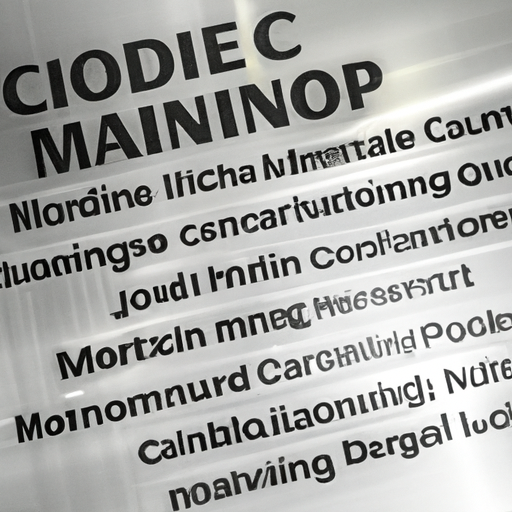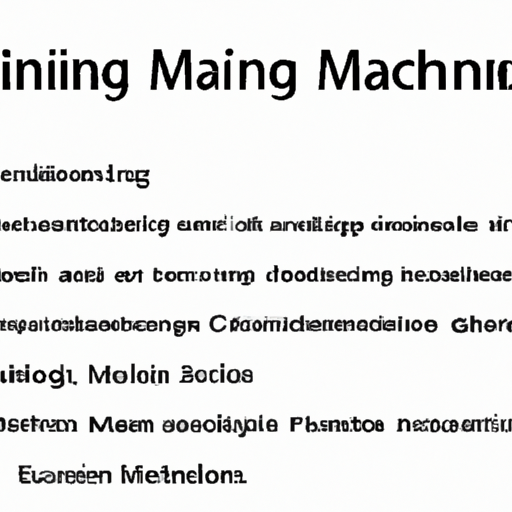Title: Demystifying the CNC Machinist Job Description: Navigating the Skills and Responsibilities
Introduction:
In modern manufacturing, Computer Numerical Control (CNC) machines have revolutionized the precision and efficiency with which industrial components are produced. At the heart of these cutting-edge technologies stand the skilled machinists who bring them to life. The role of a CNC machinist has become increasingly vital, demanding professionals knowledgeable in both traditional tool and die making techniques as well as programming and operating advanced CNC machinery.
This article aims to provide a comprehensive overview of the CNC machinist job description, shedding light on key responsibilities, required skills, and the unique challenges faced in this rapidly evolving industry. In scrutinizing the intricate dance between human expertise and automated precision, we seek to better understand the essential role CNC machinists play in shaping our technological landscape.
Delving deep into the realm of CNC machining, we will explore the intricate workings of machining operations, the diverse range of materials involved, and the various tools and technologies employed. Additionally, we will highlight the essential skills and qualifications that are fundamental to achieving success in this dynamic field, paying special attention to the ever-evolving landscape of technical skills and programming proficiencies.
Furthermore, this article recognizes the pivotal role that CNC machinists entail within the manufacturing process, emphasizing their ability to interpret blueprints, select appropriate tools, meticulously program cutting paths, and employ quality control measures. By enabling readers to grasp the intricacies of this highly technical trade, we aim to foster an appreciation for the precision and expertise demonstrated by CNC machinists on a daily basis.
Through an unbiased and neutral lens, this article will help individuals looking to pursue a career as CNC machinists, as well as those seeking to gain a deeper understanding of this remarkable occupation. By exalting the profession, we hope to encourage dialogue around the substantial impact CNC machinists have on the global industrial landscape and their contributions to technological advancements.
Embark on this informative journey with us, as we demystify the CNC machinist job description, elucidate the core competencies required, and delve into the intricacies of this ever-evolving profession. Understanding the vital roles and responsibilities of CNC machinists will undoubtedly grant us a clearer perspective on the significance and potential that this profession holds within the world of manufacturing.
Table of Contents
- Key Responsibilities of a CNC Machinist
- Required Skills and Qualifications for CNC Machinists
- Understanding CNC Machinery and Equipment
- Interpreting Blueprints and Specifications for Precision Engineering
- Efficient Programming and Operation of CNC Machines
- Ensuring Quality Control and Precision in CNC Machining
- Implementing Safety Measures in CNC Machining Operations
- Continuous Learning and Adaptation in the Role of a CNC Machinist
- In Summary

Key Responsibilities of a CNC Machinist
A CNC machinist plays a crucial role in the manufacturing industry, responsible for producing high-quality precision parts using computer numerical control (CNC) machines. This highly skilled professional operates and sets up these machines to perform various machining tasks, ensuring consistent and accurate production.
The include:
- Interpreting blueprints, technical drawings, and specifications to understand the machining requirements
- Programming and operating CNC machines to execute cutting, grinding, milling, drilling, and turning operations
- Setting up and adjusting machine tools, such as lathes, grinders, and mills, to achieve precise measurements and finished products
- Monitoring and inspecting machined parts during the production process to verify compliance with specifications and ensure quality control
- Performing routine maintenance on machines and making necessary repairs to ensure optimal machine performance
Attention to detail, proficiency with computer programs, and a strong understanding of machining techniques are essential for a CNC machinist to excel in their role. Alongside technical expertise, they must also possess problem-solving skills to effectively troubleshoot any issues that may arise during production. Adhering to strict safety protocols and maintaining a clean and organized workspace are vital to ensure a safe and efficient manufacturing environment.

Required Skills and Qualifications for CNC Machinists
As a CNC Machinist, there are certain skills and qualifications that are essential for success in this role. These skills will enable you to operate computer numerical control (CNC) machines effectively and efficiently, producing high-quality machined parts. To excel in this position, you should possess the following key skills and qualifications:
- Technical Proficiency: A strong understanding of CNC machining operations, including knowledge of machine setup, programming, and operation is required. Proficiency in reading blueprints, technical drawings, and schematics is also necessary.
- Attention to Detail: Precision and accuracy are crucial in CNC machining. Being detail-oriented and meticulous in your work will ensure the production of precise and error-free parts.
- Problem-Solving Skills: CNC Machinists encounter various challenges during the machining process. The ability to identify and troubleshoot mechanical issues, adjust machine settings, and program modifications when required is vital.
- Mathematical Aptitude: Strong mathematical skills, including a solid understanding of geometry and trigonometry, are necessary for effective CNC machining. These skills will help you accurately calculate dimensions, angles, and offsets.
- Physical Stamina: Operating CNC machines may involve standing for long periods, lifting heavy materials, and working in a noisy environment. Physical stamina and the ability to handle these demands are essential.
In addition to these skills, a formal education or certification in machining or a related field is highly desirable for CNC Machinists. Some companies may also prefer candidates with prior experience in CNC machining or apprenticeship. By possessing these skills and qualifications, you will be well-equipped to excel in a CNC Machinist role and contribute to the production of quality machined components.

Understanding CNC Machinery and Equipment
In the world of manufacturing, CNC machinery plays a crucial role in ensuring efficient and precise production processes. If you’re considering a career as a CNC machinist, it’s essential to understand the intricacies of the job and the equipment involved. CNC, which stands for Computer Numerical Control, refers to the automation of machine tools through the use of pre-programmed commands. This technology enables machinists to create complex and intricate parts with exceptional accuracy.
As a CNC machinist, you will work with a variety of equipment, including lathes, mills, grinders, and routers. These machines are controlled by computer programs that guide the tools to shape and cut materials such as metal, plastic, or wood. Your role will involve interpreting designs, setting up and operating the machinery, and monitoring the production process to ensure quality and precision. Attention to detail and a strong understanding of technical specifications are essential traits for a successful CNC machinist.
Interpreting Blueprints and Specifications for Precision Engineering
As a CNC machinist, a crucial aspect of your job is . This skill is instrumental in ensuring accurate and high-quality production outcomes. To excel in this area, it’s essential to have a deep understanding of blueprint reading, technical drawings, and detailed specifications. By carefully analyzing these documents, you can effectively translate complex information into precise instructions for CNC machines.
One of the key tasks in interpreting blueprints and specifications is identifying and comprehending geometric dimensions and tolerances (GD&T). This involves deciphering symbols, annotations, and callouts on blueprints to determine the allowable variations in size, shape, and position of features. Familiarity with the various GD&T symbols and their meanings is imperative for executing machining operations accurately. By using unnumbered lists, you can easily categorize and understand the different GD&T symbols for quick reference:
- Position: Specifies the location of a feature relative to a datum or the origin of the coordinate system.
- Concentricity: Defines the relationship between two axisymmetric features, ensuring their axes coincide.
- Flatness: Determines the degree of deviation from a true flat surface; important for mating parts.
- Circularity: Establishes the tolerance for roundness in cylindrical features or profiles.
- Parallelism: Ensures that two surfaces or axes are equidistant at all points.
By honing your ability to interpret blueprints and specifications effectively, you will contribute to the successful execution of precision engineering projects and the production of top-notch machined components.
Efficient Programming and Operation of CNC Machines
One crucial aspect of being a CNC machinist is the ability to efficiently program and operate CNC machines. This skill is essential for maximizing productivity and ensuring accurate and precise machining processes. By utilizing efficient programming techniques, machinists can reduce cycle times, minimize tool wear, and optimize tool paths, ultimately resulting in cost savings and increased efficiency.
To be an effective CNC machinist, it is essential to have a deep understanding of CNC programming languages such as G-code and M-code. These programming languages allow machinists to communicate instructions to the CNC machine, indicating the desired cutting paths and operations. By utilizing the full capabilities of these languages, machinists can write concise, error-free programs that will execute precisely as intended.
- Identify optimized tool paths to minimize cycle time and reduce tool wear.
- Utilize advanced CAM software to generate efficient CNC programs.
- Perform thorough tooling analysis and selection to ensure optimal machining results.
- Take advantage of adaptive machining strategies to adapt to changing conditions and maximize efficiency.
In addition to programming, efficient operation of CNC machines is equally important. Machinists must have a comprehensive understanding of machine controls, tooling setups, and workpiece fixturing techniques. They must be skilled in loading and unloading workpieces, tool changes, and machine calibration, ensuring smooth and consistent operations throughout the machining process.
By implementing efficient programming and operation techniques, CNC machinists can significantly improve productivity, reduce downtime, and achieve superior machining results. Their expertise in these areas is vital for meeting tight deadlines, delivering top-quality products, and driving overall business success.
Ensuring Quality Control and Precision in CNC Machining
In order to effectively fulfill the role of a CNC machinist, it is essential to possess expertise in quality control and precision. The ability to ensure the highest level of accuracy and consistency in CNC machining processes is paramount to producing high-quality products. By diligently adhering to industry standards and meticulously inspecting finished products, CNC machinists play a critical role in maintaining the integrity and reputation of the manufacturing company.
One of the key responsibilities of a CNC machinist is to conduct thorough inspections throughout the machining process. This involves utilizing advanced measuring tools and techniques to verify that the specifications and dimensions of the finished product align with the project requirements. By paying meticulous attention to detail, CNC machinists can identify and rectify any deviations or errors, thereby ensuring the final product meets the highest standards of quality.
- Performing precise measurements using advanced measuring tools such as calipers and micrometers
- Conducting thorough inspections at each stage of the machining process to ensure conformity to project requirements
- Identifying and troubleshooting any issues related to the CNC machine’s performance or the material being worked on
- Collaborating with engineers and designers to optimize machining programs for increased precision and efficiency
By upholding meticulous quality control practices and consistently striving for precision, CNC machinists contribute to the overall success of a manufacturing operation. Their expertise and attention to detail are instrumental in delivering products that meet or exceed customer expectations.
Implementing Safety Measures in CNC Machining Operations
Ensuring the safety of operators and safeguarding the CNC machining environment is paramount in any manufacturing setting. Implementing effective safety measures not only protects personnel from accidents or injury but also optimizes productivity and minimizes downtime. By adhering to the following guidelines, CNC machinists can create a safe and secure work environment:
- Invest in proper training: Providing comprehensive training to CNC operators is essential to ensure they have the necessary skills and knowledge to operate the machinery safely. Training should cover machine operation, emergency procedures, and the proper use of personal protective equipment (PPE).
- Regular maintenance and inspections: Conducting routine maintenance checks and inspections on CNC machines can help identify potential hazards or malfunctions. Regular lubrication, cleaning, and calibration will not only extend the machines’ lifespan but also enhance their performance while reducing the risk of accidents.
- Establish clear safety protocols: Developing and enforcing strict safety protocols is crucial for CNC machining operations. This includes designating areas for machine operation, restricting access to authorized personnel only, and implementing lockout/tagout procedures to prevent accidental machine startup during maintenance or repairs.
Continuously monitoring and updating safety procedures is vital to keep pace with evolving technology and industry advancements. Encouraging regular communication and feedback between machinists, supervisors, and safety personnel can help identify potential risks and implement necessary safety measures promptly. By prioritizing safety, CNC machinists can work in a secure environment that promotes efficiency, productivity, and overall well-being.
Continuous Learning and Adaptation in the Role of a CNC Machinist
Continuous learning and adaptation are essential in the role of a CNC machinist. As the field of manufacturing and precision machining continues to evolve, it is crucial for CNC machinists to stay current with the latest technologies, tools, and techniques. This ongoing learning process ensures that they can effectively operate computer numerical control (CNC) machines and produce high-quality machined parts with utmost precision and accuracy.
Being a CNC machinist requires a diverse skill set, as they are responsible for programming, setting up, and operating CNC machines to perform various tasks such as cutting, milling, drilling, and shaping materials. To succeed in this role, continuous learning and adaptation are necessary to keep up with changing industry trends and advancements. CNC machinists must regularly update their knowledge on CAD/CAM software, machine programming languages, and machine maintenance procedures.
- Knowledge of CAD/CAM software: CNC machinists should have a comprehensive understanding of computer-aided design (CAD) and computer-aided manufacturing (CAM) software. This enables them to efficiently program CNC machines and create detailed specifications for machining processes.
- Familiarity with machine programming languages: Proficiency in machine programming languages like G-code and M-code is crucial for CNC machinists to optimize machine performance and ensure accurate machining operations.
- Ability to interpret technical drawings: CNC machinists must be skilled in reading and interpreting technical drawings, blueprints, and schematics. This allows them to understand the specific requirements and dimensions needed for machining different parts.
- Continuous improvement mindset: To adapt to new technologies and advancements, CNC machinists should embrace a continuous improvement mindset. This involves seeking out new training opportunities, attending workshops or seminars, and staying up to date with industry publications and resources.
In Summary
In conclusion, the CNC Machinist job description serves as a comprehensive guide outlining the roles and responsibilities associated with this vital position in the manufacturing industry. With its emphasis on precision, technical expertise, and problem-solving skills, this position plays a crucial role in ensuring the smooth operation of a range of CNC machinery. From reading and interpreting blueprints to programming and operating CNC equipment, these skilled professionals are integral to the production process, guaranteeing accuracy and efficiency. Furthermore, a successful CNC Machinist must possess a keen attention to detail, exceptional mathematical skills, and the ability to work independently or as part of a team. As technology advancements continue to revolutionize the manufacturing landscape, the demand for CNC Machinists is expected to grow, making it an opportune career choice for individuals seeking stability and growth in a dynamic industry. Whether you are an aspiring CNC Machinist or an employer seeking top talent, understanding the intricacies of this occupation is instrumental in achieving success.
